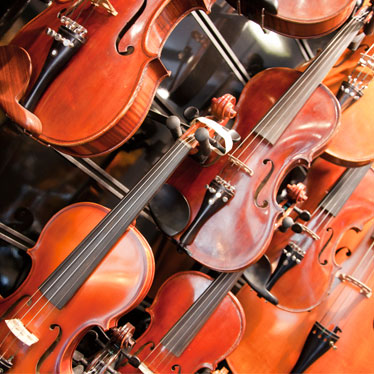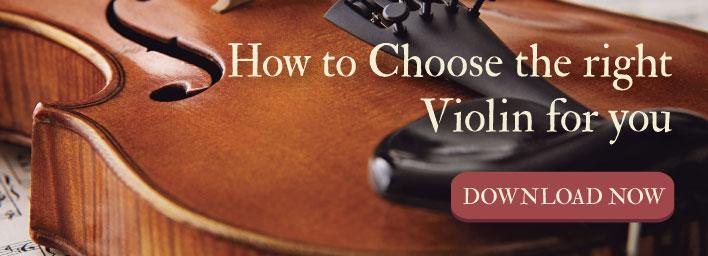7 Tips for Choosing the Right Violin for Beginners

Find yourself faced with choosing a violin for a beginner student and feeling overwhelmed? You’re not alone. Many parents and students are bewildered by the amount of different violins available. Obviously you want to get the best instrument for your money, but if you’ve never played music yourself, buying or renting a beginner violin can present a challenge.
However, knowing how to choose a violin can help you, and it will help the student make progress. For the first few years, learning to play the violin is tough. Students need all of the encouragement they can get from their instrument. If it sounds good and has good playability, students will be more likely to stay the course and develop a truly wonderful skill that will benefit them all of their lives. These practical tips can help you learn how to choose a violin, and ensure that the selection you make is well-matched to your student.
Buy or Rent?
There are a number of great beginner violins available, and at very affordable prices. However, if your student isn’t quite sure whether or not the violin will suit his or her personal taste, renting your beginner violin for a few months is a good idea. Likewise, if your student is very young and requires a violin less than ½ size, renting might be the solution. However, there are many, very excellent, used violins for sale in these sizes.
Size Matters
Never purchase or rent a beginner violin that is too big. Playing on the wrong size instrument creates serious problems with technique, and can eventually lead to chronic neck, back, and arm injuries. Be sure to know exactly what size will work for your student (or yourself, if you’re the beginner). Don’t forget to account for age, body size, hand shape, and physical strength. If in doubt, going with a smaller size is better than playing on a violin that is too big.
Craftsmanship and Materials
This factor is probably the most important when learning how to choose a violin. Violin construction was perfected about 300 years ago, and the violins made today are crafted in the same way. Since hand-crafted instruments are very costly, precision manufacturing has emerged as an effective way to make intermediate and beginner violins. Violins are crafted from specific tonewoods, such as Spruce and Maple, and a good indicator of quality is the depth of carving on the scroll. A deep carving typically indicates superior craftsmanship. Also look at the joining areas around the body, they should fit tightly. The violin itself should feature symmetrical alignment, i.e. the neck and endpin should line up.
Ask the Experts
Speak with violinists (teachers) in your area and the experts at your local violin shop, one that conducts instrument repairs. These craftsmen, called luthiers, are happy to share their expertise about particular instruments and brands. Rather than speaking from a sales standpoint, luthiers and teachers have an abiding love of the instrument and like true enthusiasts, will want to impart their wisdom to beginners.
The Set Up Process
The set up process greatly effects the playability and tonal quality of your beginner violin. Although poor quality materials can hardly be negated by a great set up, when it is executed correctly, the right set up can make all the difference in your sound. A few areas to consider include:
- The nut—the groove depth dictates the violin’s “action” (how hard it is to press the strings down to the fingerboard). If it’s too high, it makes it hard to play, too low and the strings will buzz.
- The strings—steel strings are very common, but beginner violins and violinists often benefit from having synthetic core strings. They sound so much richer and are very responsive. Moreover, Thomastik-Infeld makes a fantastic, affordable (around $20 for the set), Alphayue string that is perfect for beginners.
- The Bridge—like the nut, the bridge effects the playability of the instrument. It should be fitted perfectly to the top plate of the violin, and should be shaped appropriately. If the grooves are too close together, string crossings are difficult.
Chin and Shoulder Rest Considerations
The chin rest should fit the player’s chin and be placed so that it isn’t uncomfortable. Ideally, you want to choose accessories that make playing feel natural. Likewise, a good shoulder rest is important for beginners so that they can maintain good posture.
Hear it Played
It’s crucial for the player to like the sound of his or her instrument. Since violins are made from organic materials, they each have their own unique sound. Have someone with you when choosing, and make sure that you hear the violin before buying or renting.
By following these tips, you’ll choose a great violin that will last for years.


